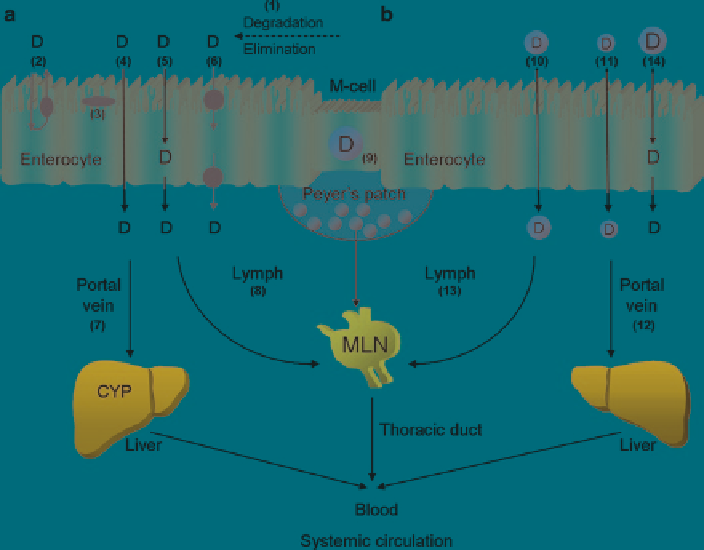Biomedical Engineering Reference
In-Depth Information
(Fig.
1a
-1) (Bernkop-Schnurch and Schmitz
2007
) or in the liver (first-pass
metabolism). In any case, overcoming these hurdles is the major challenge in develo-
ping oral cancer therapy.
In general, drugs are orally absorbed by a transcellular route (through the cell);
although, in some cases, a paracellular pathway and a carrier-mediated mechanism
can also occur. The transcellular transport of a molecule can take place by a passive
mechanism (Fig.
1a
-5) or be mediated by a specific carrier (Fig.
1a
-6). In the first
case, the molecule have to show the adequate physicochemical properties (such as
Fig. 1
Intestinal absorption of drugs (
a
) or drug-associated nanoparticles (
b
). In the intestinal gut,
drug can suffer enzymatic or chemical degradation (
1
). The drug once is dissolved in the aqueous
fluids of the gastrointestinal tract, must diffuse through the mucosa and reach the intestinal epi-
thelium in order to be absorbed. Some drugs will not arrive to the systemic circulation due to
efflux mechanism by P-gp (
2
) or intestinal degradation by CYP (
3
).The physico-chemical proper-
ties of the drug will determine the mechanism of absorption: paracellular diffusion (
4
); transcel-
lular passive diffusion (
5
); carrier-mediated transcellular transport (
6
). After absorption, some
drugs go to blood and then to the liver through the portal vein (
7
). Other drugs go to the mesenteric
lymph nodes and reach the blood systemic circulation by the thoracic duct (
8
). The association of
drug to nanoparticles (
b
) can protect it from degradation and avoid the efflux mechanisms. These
nanocarriers can cross the epithelium either via M-cells (
9
) or via enterocytes by endocytic path-
ways (
10
and
11
) and they will reach the systemic circulation via portal vein and liver (
12
) or via
lymphatic system (
13
). However, in general most of nanocarriers designed for oral administration
do not cross the epithelium themselves; instead prolong the contact of the drug with the mucosa
(i.e. bioadhesive nanoparticles), increasing the bioavailability (
14
)

Search WWH ::

Custom Search